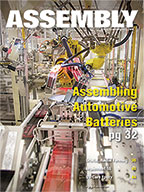Studies of fastening costs are generally only valid for an existing design and don't predict the potential costs savings in changing designs. Cost-reduction efforts should focus on three areas: significant product redesigns; superficial design changes; and assembly labor reduction.
As with any cost-reduction effort, examining the sources of current cost is a good starting point for cutting the cost of fastening. A recent study of fastening costs breaks them into labor, warranty, engineering, utilities, parts and tools, with relative costs estimated at 50 percent, 25 percent, 14 percent, 6 percent, 4 percent and 1 percent, respectively. For more details, see Archetype Joint’s Web site.
Other studies that consider only direct costs estimate the cost of the fastener at 10 percent to 20 percent of the total, with the remainder divided between labor and assembly tools.
Studies of fastening costs are generally only valid for an existing design and don’t predict the potential cost savings in changing designs. With this in mind, the cost-reduction observations made in this column will be grouped into three categories: New products where the changes are more than incremental improvements; new or existing products where only superficial changes can be made; and improvements to the assembly of existing products.
Significant product redesigns. Joint design and fastening does not drive product design, nor should the design have to accommodate existing or preordained fastening approaches. The most competitive designs are often developed by first conceiving the simplest product architecture that can provide the required functionality without consideration of unit cost, development schedule or technical challenges.
Try forcing each dose of “reality” to prove that some aspect of this ideal design really isn’t possible. The final result will be closer to that ideal than by using the more common approach of taking the current or obvious solution and thinking of ways to improve it.
Joint design should provide solutions to allow the design to come as close to that ideal as possible by not requiring compromise. For example, if there are advantages in using components with inherently poor dimensional stability or accuracy, don’t try to force a material change to make fastening easier.
Using techniques that might seem to go against guidelines, like providing the features required for fastening at assembly or using fasteners that create their own holes, might be the best overall solution. However, if the components are very thin and light, and only get their structure at assembly, perhaps fasteners aren’t the best solution due to the localized stresses they tend to induce. Joining with adhesives might be a better application. Consideration should always be given to eliminating all permanent joints when the joined components do not possess fundamentally different material properties.
Superficial design changes. These cost-reduction efforts are usually applied to existing products. It often involves changing suppliers to achieve improvements in cost, quality and delivery. Whether changing the fastener or modifying the clamped component, careful consideration should be given to implementing changes in existing designs purely for cost reduction.
This is because the upside is generally limited to the value of the cost reduction, while the potential for negative surprises is high when the impact of the change is not fully thought out or tested. When this due diligence isn’t possible or palatable, the return on investment needs to be great enough to cover the potential application of Murphy’s Law.
Assembly labor reduction. While the same caution mentioned for existing design changes also applies to assembly processes, the ripple effect of assembly changes tends to be more confined when parts don’t need revision. Also, the potential labor savings is often greater than can be gained by changing the fastener.
Our study also pointed out that the cost of defects is high. Since all assembly operations can be the focus of cost-reduction activity, it makes sense to concentrate efforts on operations that can provide benefits both to direct labor costs and to indirect costs. Operations causing consistent rework or product failures don’t need cost-reduction activities to get attention.
When surveying less obvious cost-reduction targets, I suggest studying operations that have a steep learning curve for new operators. They tend to have greater product variation that can cause line balance problems.
Also, simple improvements can make a difference in easing tool and fastener alignment, a common way to reduce labor time during assembly. Examples are tool orientation, tool speed and ergonomics (height, part position and access). Other improvements include locating the clamped part and eliminating long, loose bit extensions. A
Archetype Joint specializes in joint design, testing and validation. Dave Archer can be contacted at darcher@archetypejoint.com
Get our new eMagazine delivered to your inbox every month.
Stay in the know on the latest assembly trends.
SUBSCRIBE TODAY!Copyright ©2024. All Rights Reserved BNP Media.
Design, CMS, Hosting & Web Development :: ePublishing



